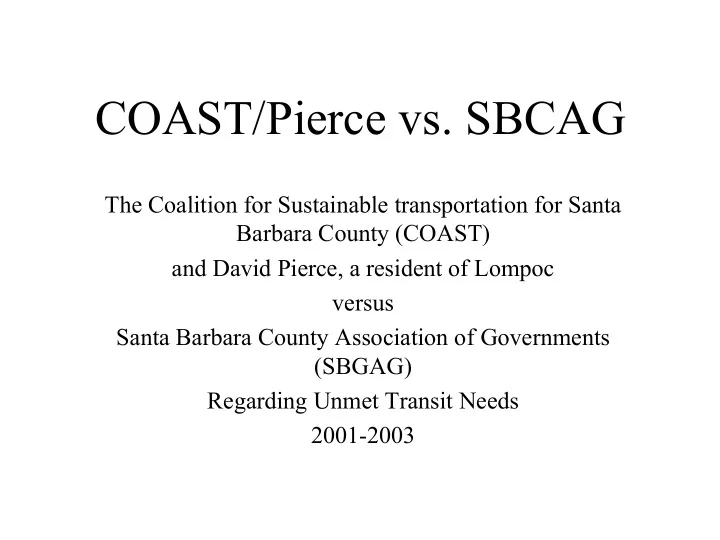

COAST/Pierce vs. SBCAG The Coalition for Sustainable transportation for Santa Barbara County (COAST) and David Pierce, a resident of Lompoc versus Santa Barbara County Association of Governments (SBGAG) Regarding Unmet Transit Needs 2001-2003
Santa Barbara’s North County: Cities interspersed among rural areas
Santa Maria Area Transit District (SMAT) City of Lompoc Transit District (COLT) Santa Ynez Valley Transit (SYVT) Transit Districts in Santa Barbara County: • An independent transit agency in the South Coast (SBMTD) • Transit services provided by different jurisdictions in North County
Transit Dependency Indicators: North County and South Coast have similar Transit Dependency Indicators
Households without vehicles: North County and South Coast have similar percentages of households without vehicles
Commuting in Santa Barbara County North County residents have longer commutes than South Coast residents, except for Carpinteria
Geographical distribution of poverty: The majority of the lowest income population lives in the North County
The North and South portions of the County have about the same population but 9 out of 10 transit trips in Santa Barbara County take place in the South Coast
Why? • The South Coast has a long established independent transit agency (MTD) that requests and invests all available TDA funds in transit. • Development patterns in the South Coast are more conducive to transit. •Political leaders in the North are more conservative and adverse to transit development. •Transit services are under the control of Public Works Directors that have competing priorities for TDA funds, e.g. road maintenance. •The MPO Board that authorizes the TDA findings (SBCAG) has a majority of members from the North County (8 versus 5).
SBCAG Board of Directors 13 Board Members: • 5 County Supervisors • 8 Incorporated City Representatives • Every City has one vote, regardless of population. • 5 Cities are located in the North County. • 3 Cities are located in the South Coast. NORTH AND SOUTH AREAS OF THE COUNTY HAVE EQUAL POPULATION BUT North County Representatives have a voting majority on SBCAG Board
Intercommunity transit in North County • “Clean Air Express” (commuter express service from Lompoc and from Santa Maria to Goleta and Santa Barbara) •San Luis Obispo RTA (Line 10) (Santa Maria to San Luis Obispo) • Guadalupe Flyer (Guadalupe to Santa Maria). • Chumash Casino bus (Lompoc & Santa Maria to casino in S.Y. Valley) • All of these services continue in operation. Clipper Service • “Clipper Service” linking Lompoc, Santa Maria and the Santa Ynez Valley was established in 1997 and eliminated in 1999. • Initially restricted to social service clientele. • Later available to the general public, but without marketing. • Insufficient promotion of the service. • Lack of sustaining, dedicated funding source.
History of a lawsuit • As a result of public testimony requesting the continuation and improvement of transit service linking the North County communities, SBCAG Board indicates its commitment to study and develop a proposal. • In 1999 the City of Solvang conducted a study (“Crane Study”) outlining previous mistakes and the feasibility of a successful service. • In the 2001 UTN Finding Process, SBCAG delayed the implementation of this service and hired a new consultant to refute the previous projections (“Moore Study”). • COAST Board of Directors votes to retain the legal services of Marc Chytilo to review the legality of SBCAG’s actions. • COAST hires a consultant, Cliff Chambers, to review the Moore Study. Chambers shows methodology mistakes in that study. • David Pierce, a resident of Lompoc, joins the lawsuit. A social advocate group (SB CAN) joins the effort with the distribution of transit surveys. • In December 2001 SBCAG adopts findings of Unmet Transit Needs, but not reasonable to meet based on low ridership.
• COAST/Pierce file suit. • The compilation of records delays the process. • COAST and SB CAN bring great public participation and public exposure to the 2003 UTN process by distributing transit surveys on buses and writing letters to newspapers. • Vandenberg Air Force Base (VAFB), located between Lompoc and Santa Maria, indicates a strong desire for commute service. (Bus service is considered a lower security risk.) • On June, 2003 the case is settled out of court. SBCAG pays legal fees and agrees to a 3-year pilot project connecting Lompoc, VAFB and Santa Maria. • Project to be funded by CMAQ, with local component (10%) from LTF funds. SBCAG commits to prepare a service plan within a year. • Service Plan draft recently completed. This plan will be presented to SBCAG on 4/15/04 and adopted on the next meeting.
Recent Developments • New Unmet Transit Needs arise. • COAST contacts farmworkers’ representatives and urges attendance at the 2004 UTN hearings. • 8 farmworkers attend the January 2004 meeting in Santa Maria to describe their arduous and dangerous trip to work every morning. 55 of them return in February for televised testimony. • Farmworkers meet with SBCAG staff and Directors, social workers and clergy to state their needs. COAST documents the location of their residences (origins) and places of work (destinations) in the 2004 UTN “white paper”. • There are about 10,000 farmworkers in Santa Maria. 9,000 of them are Mixtec Indians originally from Oaxaca, Southern Mexico. Between 15,000 and 28,000 Mixtecs live within Santa Maria City limits. • 2004 Unmet Transit Needs Process currently in progress. Staff provides excellent outreach and analysis, but it is cowered into denying the existence of transit needs that could use TDA funds.
Notice that the only intercommunity services that are “Reasonable to Meet” are those that will not require use of North County TDA funds (Settlement & MTD’s)!!
Recurring Issues • Vague standard in Statute, allowing Agency to define “Unmet Transit Need” and “Reasonable to Meet”. • Lack of clarity over farebox recovery requirements: • 20% for urban areas. • 10% for rural areas. • 15% for hybrid service? • Agency can decide farebox recovery minimums. www.coast-santabarbara.org
Recommend
More recommend